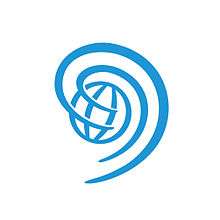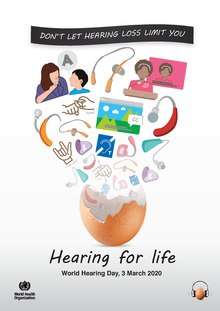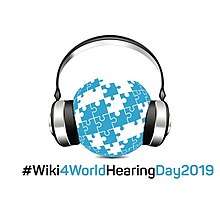World Hearing Day
World Hearing Day is a campaign held each year by Office of Prevention of Blindness and Deafness of the World Health Organization (WHO). Activities take place across the globe and an event is hosted at the World Health Organization on March 3rd. The campaign's objectives are to share information and promote actions towards the prevention of hearing loss and improved hearing care. The first event was held in 2007.[1] Before 2016 it was known as International Ear Care Day.[2] Each year, the WHO selects a theme, develops educational materials, and makes these freely available in several languages. It also coordinates and reports on events around the globe.

2020


The theme of the campaign for 2020 is "Hearing for Life. Don't let hearing loss limit you".[3] The selection of the theme by the World Health Organization expresses the key message that timely and effective interventions can ensure that people with hearing loss are able to achieve their full potential. It recognizes that, at all life stages, communication and good hearing health connect us to each other, our communities, and the world. It highlights that appropriate and timely interventions can facilitate access to education, employment and communication. Unfortunately, across the globe, ear and hearing care are insufficient, and the WHO argues that all public health systems should include ear and hearing care.
Previous years
2019: The theme of the campaign for 2019 was "Check your hearing" as data from both developed and developing countries indicate that a significant part of the burden associated with hearing loss comes from unaddressed hearing difficulties.[4][5]
A study conducted in the United Kingdom indicate that only 20% of those who have a hearing problem seek treatment.[6][7] A study performed in South Africa reported that individuals who experience hearing difficulties wait between 5 and 16 years to seek diagnosis and treatment.[8] Two hundred and ninety one events/activities from 81 countries were registered, and will be described in their annual report. For the celebration, on February 25 2019 WHO launched hearWHO, a free application for mobile devices which allows people to check their hearing regularly and intervene early in case of hearing loss.[9] The app is targeted at those who are at risk of hearing loss or who already experience some of the symptoms related to hearing loss.
Wiki4WorldHearingDay2019, an edit-a-thon, was part of the 2019 activities of the campaign, to facilitate the contribution of hearing-related content into Wikipedia in several languages. Activities were reported in a Wikimedia dashboard and summarized a few publications.[10][11] In addition, a Meet-up took place with presentations by researchers from HEAR in Cincinnati, from the National Institute for Occupational Safety and Health, the National Center on Birth Defects and Developmental Disabilities and National Center for Environmental Health, of the Centers for Disease Control and Prevention, by the Wikipedian-in-Residence from the National Institute for Occupational Safety and Health, and the Wikipedia Consultant for Cochrane.
2018: The theme of World Hearing Day 2018 was "Hear the future" to highlight the estimates of an increase in the number of people with hearing loss around the world in the coming decades.[12]
2017: The theme of World Hearing Day 2017 was “Action for hearing loss: make a sound investment”, which focused on the economic impact of hearing loss.[13]
2016: The theme of World Hearing Day 2016 was “Childhood hearing loss: act now, here is how!” which provided information on public health measures that could prevent significant percentage of cases of hearing loss in children.[14]
2015: The theme for World Hearing Day was “Make Listening Safe”, which drew attention to the rising problem of noise-induced hearing loss due to recreational exposure.[15]
References
- "World Hearing Day: 3 March". WHO. Retrieved 16 January 2017.
- "International Ear Care Day: 3 March". WHO. Retrieved 22 September 2016.
- "World hearing day 2020: Hearing for life". Retrieved 11 December 2019.
- The Lancet (2017-12-02). "Hearing loss: time for sound action". The Lancet. 390 (10111): 2414. doi:10.1016/S0140-6736(17)33097-0. ISSN 0140-6736. PMID 29208294.
- "World Hearing Day 2019". Retrieved 11 December 2019.
- A, Davis; P, Smith; M, Ferguson; S, Stephens; I, Gianopoulos (2007-11-07). "Acceptability, benefit and costs of early screening for hearing disability: a study of potential screening tests and models". Health Technology Assessment. 11 (42). doi:10.3310/hta11420. ISSN 2046-4924.
- "Untreated Hearing Loss in Adults—A Growing National Epidemic". American Speech-Language-Hearing Association. Retrieved 2018-12-21.
- Ratanjee-Vanmali, Husmita; Swanepoel, De Wet; Laplante-Lévesque, Ariane (2018). "Characteristics, behaviours and readiness of persons seeking hearing healthcare online". International Journal of Audiology: 1–9. doi:10.1080/14992027.2018.1516895. PMID 30289050.
- "WHO | hearWHO". WHO. Retrieved 11 December 2019.
- Morata, Thais C.; Chadha, Shelly (2019-05-05). "Make Quality Hearing Health Information Available to All:". The Hearing Journal. 72 (5): 6. doi:10.1097/01.HJ.0000559493.29061.35. ISSN 0745-7472.
- "World Hearing Day 2019 – Report of Activities" (PDF). Retrieved 11 December 2019.
- "3 March 2018: World Hearing Day". Retrieved 11 December 2019.
- "World Hearing Day 2019". World Health Organization. Retrieved 11 December 2019.
- "WHO | 3 March 2016: World Hearing Day". WHO. Retrieved 11 December 2019.
- "WHO | Make Listening Safe". WHO. Retrieved 11 December 2019.
External links
- World Health Organization, Prevention of Blindness and Deafness, World Hearing Day.
- A recording for 2019 meetup for the Wiki4WorldHearingDay2019 campaign.
- Make Listening Safe, initiative by the World Health Organization to promote safe listening practices